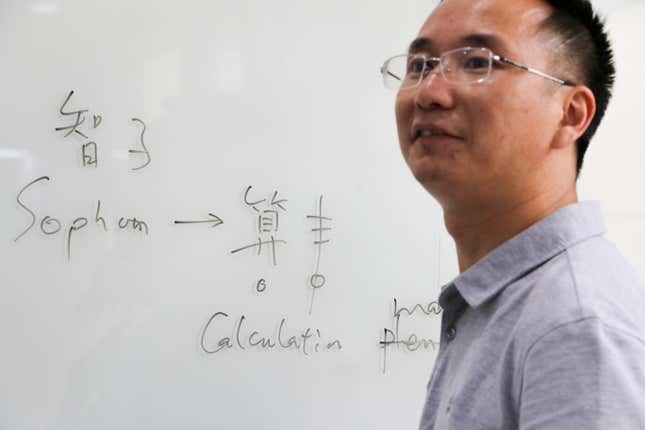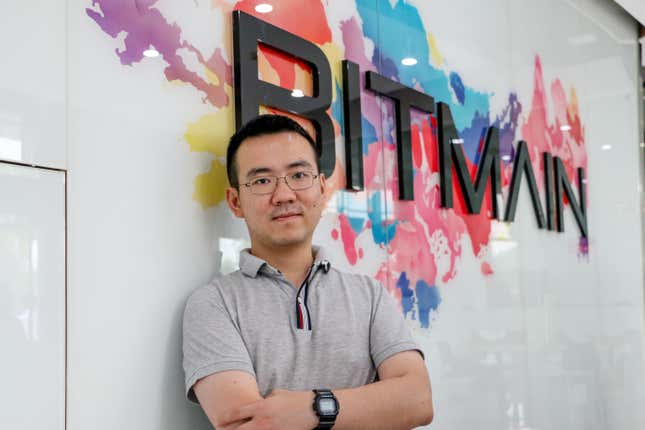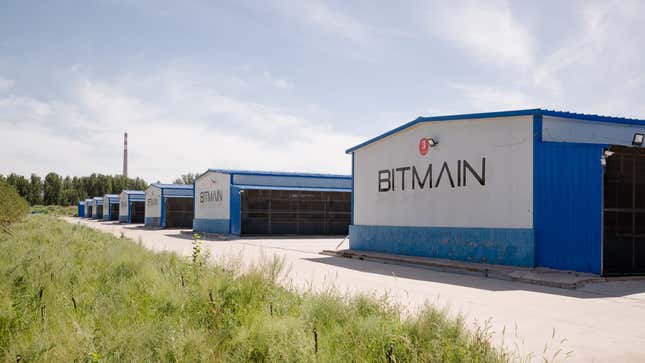Two years ago, a Chinese chip-design expert named Micree Zhan was reading China’s seminal science-fiction novel, The Three-Body Problem, by Liu Cixin, while wrestling with how to create a new processor. He had already designed custom chips for the company he co-founded, Bitmain, that had made it into the world’s leading bitcoin miner, allowing it to dominate the new, hyper-competitive industry of unearthing bitcoins. Now he needed a chip that could launch Bitmain onto a new trajectory, one that would help it master a world-altering technology called deep learning, a branch of artificial intelligence.
While performing his nightly meditation, a practice he has kept up for nearly a decade, it suddenly came to Zhan. “It was late at night, and something inspired me—Sophon!” he recalls. A sophon is a fictional proton-sized supercomputer from The Three-Body Problem that is sent by an alien civilization to halt scientific progress on Earth. It’s capable of causing strange phenomena—such as inscribing flashing words on the retinas of elite scientists. The aliens use it to take over Earth when their own planet is destroyed by the chaotic gravitational forces of its three suns.
Bitmain’s newest product, the Sophon, may or may not take over deep learning. But by giving it such a name Zhan and his Bitmain co-founder, Jihan Wu, have signaled to the world their intentions. The Sophon unit will include Bitmain’s first piece of bespoke silicon for a revolutionary AI technology. If things go to plan, thousands of Bitmain Sophon units soon could be training neural networks in vast data centers around the world.
Bitmain could pull it off, says Michael Bedford Taylor, a professor at the University of Washington who has studied the bitcoin mining industry and its specialized chips. Taylor says these types of chips, called application-specific integrated circuits, or ASICs, that are designed to perform a single function extremely efficiently could create the next wave of distributed computing (pdf). “This will invigorate the hardware field,” he says. “We are about to see the emergence of all kinds of ASICs clouds, and the bitcoin hardware community has demonstrated that under the right conditions this can happen rapidly as a grassroots effort.”
China’s shadowy colossus
To grasp how a Beijing startup is poised to challenge the likes of Google, Nvidia, and AMD in the deep learning arms race, it’s essential to understand Bitmain’s pivotal role in the $70 billion bitcoin economy. Incorporated in Hong Kong as Bitmain Technologies Ltd, Bitmain’s controlling shareholder is a trust registered in the Cayman islands.

The company is a marvel of vertical integration. Bitmain designs the silicon that goes into its bitcoin mining rigs, assembles the machines, then sells them to customers around the world. It also operates the machines for its own account, runs vast bitcoin mines that it rents out on contract to others, and, finally, manages several of the world’s largest mining “pools”—agglomerations of processing power so huge that they greatly improve the odds of successfully mining a bitcoin block.
Bitmain may now be the most influential company in the bitcoin economy by virtue of the sheer amount of processing power, or hash rate, that it controls. Its mining pools, Antpool and BTC.com, account for 28.9% of all the processing power on the global bitcoin network.
Hash rate is critical because bitcoin is in the midst of a messy “civil war.” Controlling chunks of hash rate provides miners with a public vote on the bewildering array of technical proposals dictating bitcoin’s future. At the crux of the technical debate: How to increase the number of transactions the bitcoin network can handle at any given time. The recent split of bitcoin into bitcoin and bitcoin-cash illustrated one way to do this.
Bitcoin mining is the process of checking and adding new transactions to bitcoin’s immutable ledger—its blockchain. Miners must compete with one another to be the first to find a new block. In return for performing this work, which requires massive processing power and incurs hefty electricity costs, miners are rewarded with a certain number of bitcoins for each block they add to the blockchain. Currently, that’s 12.5 bitcoins per block, and a new block is found roughly every 10 minutes. At the current bitcoin price of about $4,000, that’s $50,000 up for grabs every 10 minutes, or $7.2 million a day.
Controversy and criticism over blockchain
Wu, the business brains behind Bitmain, is a polarizing figure in the bitcoin world. He has been a vocal and vociferous proponent of one particular technical approach to increase bitcoin’s transaction capacity, one that would increase the size of bitcoin’s blocks by eliminating the 1 megabyte limit imposed by the bitcoin’s pseudonymous creator, Satoshi Nakamoto. Bitmain is among the signatories of the so-called “New York Agreement,” which calls for doubling the block size under the Segwit2x proposal. Some see this as technically risky, and philosophically fraught because it concentrates power in the hands of miners—like Bitmain. “In France, nobody likes him at all. He is despised,” said Sosthène, the pseudonym of a Parisian bitcoiner I met in Beijing.

Critics of Bitmain suspect that Wu was behind the recent, somewhat related split of bitcoin called the bitcoin-cash hard fork. That split was supported by a miner in Shenzhen named ViaBTC—which happened to be a company that Bitmain has invested in. Wu denies he was behind the split and Bitmain has publicly said it’s neutral on the matter. “If we had such an influence,” he laughs, an earlier scaling proposal called Bitcoin Unlimited, which he and other prominent figures had backed, “would have already been activated.”
Jack Liao, who runs a Shenzhen-based mining firm called Lightning ASIC, has clashed with Bitmain. He says Wu is trying to dominate the bitcoin economy and shape it for his own ends. “He wants to control the code, he wants to control the environment,” Liao says. “Then he can design the entire bitcoin ecosystem.” Liao has clashed with Wu on social media in China, claiming that he’s prepared to take legal action against Wu for bad-mouthing his company, Lightning Asic.
Wu, 31 years old, spars with his critics on Twitter, where he says he is inundated by professional trolls. He famously published an expletive-laden tweet in 2016 in response to users who he believed were trolling him during one debate about bitcoin’s future. It was promptly turned into memes and held up as evidence that Wu was unqualified to lead the conversation about influencing the future of a protocol worth $70 billion.
Wu says he regrets that particular Twitter outburst. “If I had a time machine I would not have posted that,” he says. Fixing his image problem is partly why we’ve been invited to Beijing to meet him—he rarely grants interviews—and why we were invited to visit his firm’s bitcoin mine in Inner Mongolia the day following our meeting.
Another split for bitcoin is looming in November, when the community must again decide if it will raise the block size limit. Wu, who favors the new split, says such schisms shouldn’t be avoided. “The core developers don’t own bitcoin as a whole,” he says. “Maybe they own the bitcoin-core software project, but bitcoin is not software, it is a kind of social agreement that is implemented by software. And if people do not agree with each other, a fork will be inevitable. It is only a matter of time.”
A chance encounter with a chip designer
Bitmain and Wu’s power would never have come about had it not been for a chance encounter on a Beijing street. Zhan, the Sophon chip designer and the technical brains behind Bitmain, was running a startup called DivaIP in 2010 that made a set-top box that allowed a user to stream a television show to a computer screen. One of Zhan’s staff was canvassing for customers when Wu walked by.

Wu was then in private equity, armed with a degree in economics and psychology from Peking University, China’s most august institution. Zhan, a graduate of the Chinese Academy of Sciences, famed for its technical degrees, was trying to raise funding for DivaIP, so he asked Wu for advice. Ultimately Wu couldn’t help, but three years later it would be Wu who needed Zhan.
Wu had discovered bitcoin in 2011 in a blog post, and one line stuck in his head. “They described it as the most dangerous open-source project ever,” he says. Bitcoin was envisioned as a form of stateless money that could be owned by anyone but controlled by no one—with no central bank, and no government in charge. ”Such a monetary system is possible. It doesn’t have to be government-backed. It doesn’t even have to be gold-backed,” he says.
In short order, Wu emptied his bank account to buy bitcoin, then just a fringe idea. One bitcoin could be purchased for under a dollar in early 2011. “I spent all my life savings to buy bitcoin in 2011,” he said. “Most people thought it was risky or a scam.” Two years later, bitcoin exploded, soaring from about $20 at the start of 2013 to $900 by the end of the year and, in the process, it captured mainstream attention. Wu realized that he could make money not just by trading bitcoin, but by creating it. At the time, a miner could earn 25 bitcoins every 10 minutes.
Wu had capital from his 2011 bitcoin investments. But he needed a chip designer. Remembering Zhan, Wu set out everything he understood about bitcoin in an e-mail to him. “I spent two hours reading up on bitcoin on Wikipedia,” Zhan said. “I knew it was a good thing. I decided to do this business immediately.”
Bespoke silicon for bitcoin
Zhan’s first task was designing an ASIC that would run SHA-256, the cryptographic calculation used in bitcoin, at maximum efficiency. The development of bitcoin mining ASICs escalated the race to devote greater amounts of processing power to bitcoin mining.

“In the beginning it was very tough for Micree [Zhan],” Wu says. “He complained it was impossible,” to create an ASIC for bitcoin. But Zhan, 38, got the job done, and at record speed, taking just six months from idea to finished product. Time was critical, because bitcoin prices fluctuated wildly, meaning Bitmain could miss out on a once-in-a-lifetime chance to profit from the ongoing rally. Other players were already on the scene; early ASIC makers like ASICMiner and Butterfly Labs crowdfunded their projects in 2012 to create the first generation of bitcoin ASICs.
In November 2013, Zhan’s first mining rig, the Antminer S1, was ready, and Bitmain opened for business. Sales took off. “We had very good sales during the whole of 2014,” Wu says. Indeed, bitcoin hit a historic high of nearly $1,200 in November 2013—only to crash months later after fraud was discovered at Japan’s Mt. Gox, then the largest exchange in the world.
By the end of 2014, the Mt. Gox-spurred crash put Bitmain in dire straits. Nobody wanted to be paying expensive electricity bills to mine a digital currency that was falling in value. “The price fell too low, and the whole business plan was made when the bitcoin price was high!” Wu laughs. “So when the price fell there was not much demand for our bitcoin mining rigs. Our toughest time was at the end of 2014.”
Surviving the bitcoin crash
Wu and Zhan clung on. “It was very tough,” says Zhan. “I thought if the price continues to drop maybe Bitmain will break down.” But by 2015, the cryptocurrency appeared to have bottomed out. There was increasing interest in the technical idea behind it—the immutable ledger known as the blockchain—from some of the world’s biggest banks and financial institutions.
At the same time, Zhan began working on the Antminer S5, the fifth iteration of Bitmain’s mining rig, which slashed power consumption by about a third compared to the S1. As bitcoin’s price crept up, miners returned to the scene, seizing on the Antminer S5 as their equipment of choice. “That chip was amazing,” says Wu. “It helped our company a lot.” Bitmain had a 50% profit margin on the product, according to Zhan.
The Antminer S5, which contained the BM1384 chip, turned around Bitmain’s fortunes. Wu won’t disclose the company’s revenue and earnings, except to say that it is in “a very good financial position.” He claims it is cash-flow positive, and that it has over 70% of the market for bitcoin mining rigs—effectively providing 70% of all the processing power on the network.
The firm sells hundreds of thousands of Antminers each year, according to Wang Jun, who leads work on the algorithms in Bitmain’s new deep-learning chips, and the bitcoin mining rigs are the firm’s major source of income. Wu told Bloomberg (video) that the mine in Ordos generates about $250,000 in revenue daily, and that he is planning to invest up to $200 million building new mines in the US.
Bitmain has few competitors for the Antminer. Because chip manufacturers must depend on a rising bitcoin price to sell their wares, many were unable to stay afloat when prices dropped in 2014 and 2015. Today, Bitmain’s chief competitor is San Francisco-headquartered Bitfury, which makes its own chips, sells them, and maintains mines in Georgia, in eastern Europe. It has about 6% of the global bitcoin hash rate.
Bitmain now employs 600 people headquartered in a four-story building in a high-tech park of the sort favored by tech companies in Beijing. It’s renovating the building next door because it’s running out of space. Inside, barely anyone looks older than 25, as circuit boards jostle for space with company-provided cans of Coke and other soft drinks. The majority of employees don’t have a personal interest in bitcoin, says Nishant Sharma, Bitmain’s communications manager, doing their jobs without being invested in the debates, squabbles, and philosophizing of the cryptocurrency world.
ASIC clouds: The future of deep learning?
As the price of bitcoin skyrockets, Bitmain’s future in the cryptocurrency markets seems assured. But in the artificial intelligence race, it’s a minnow in a field dominated by giants. Why should a Beijing bitcoin startup be able to compete with Google, Nvidia, and AMD?

Wang Jun, who heads the AI program under Zhan, has spent two years working on Bitmain’s deep learning chip. The idea is to etch in silicon some of the most common deep learning algorithms, thus greatly boosting efficiency. Users will be able to apply their own datasets and build their own models on these ASICs, allowing the resulting neural networks to generate results and learn from those results at a far quicker pace. This is a technique that Google’s DeepMind unit, based in London, used to train its AlphaGo artificial intelligence, using its own Tensor Processing Unit chips.
Bitmain plans to sell these chips to any corporation that wants to train its own neural nets—which means a vast swathe of the economy. Wang says tech firms like Baidu, Alibaba, and Tencent are among his target customers. Bitmain may eventually build its own data centers containing thousands of deep learning rigs and rent out that computation power to clients, just as it does with its bitcoin mines.
Wang, a veteran of Baidu and Google, argues that Bitmain has an edge in the deep-learning race because its mining technology evolved from individuals using desktop computers, to graphics cards, to custom silicon. The deep learning industry is simply going through the same evolution that bitcoin miners already experienced. So what’s next? “ASICs,” Wang says. “In the bitcoin ASIC area, who’s the best in the world? Bitmain.”
A nimble, highly focused, effort could take on the best efforts from the field’s giants, says Taylor, the professor. Bitcoin mining, with its focus on razor-thin margins and cost calculations, could have spawned a formidable competitor to the Googles and Nvidias of the world. “The companies that excelled in bitcoin mining have developed the skills to survive in an ultra-competitive, highly commoditized industry; have superior system-level design expertise and know how to keep data center costs down,” Taylor says. “The victors in the bitcoin [chip] design competition handily defeated US-based efforts.”
Money is just a story we tell each other
Zhan may have solved the problem of naming Bitmain’s deep learning ASIC, but he still has plenty on his mind. He’s months away from launching Sophon, which is due on the market before year’s end. Even after surviving the bitcoin crash of 2014, he says he still feels beset by crises and business challenges.
He turns to philosophy for guidance. Around the same time he read The Three-Body Problem, he read Sapiens: A Brief History of Humankind, by Israeli historian Yuval Noah Harari. In it, Harari argues that storytelling is the human attribute that allows groups, society, and civilization to form. “If we believe in the same story we can work together,” Zhan says.
I ask Zhan if he remembers that Harari argues that money is among the most powerful stories humans have told each other for centuries.
“Yes—money, countries, democracy, even companies—all of these things are just virtual,” Zhan says. “After reading that book, I thought, yes, he is right. It impressed me so much. It’s a very good book.”
Correction: An earlier version of this article said Micree Zhan graduated from Tsinghua; he completed work on his thesis at Tsinghua, but graduated from the Chinese Academy of Sciences.
